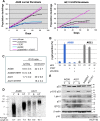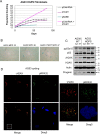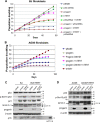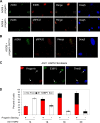Progerin-Induced Replication Stress Facilitates Premature Senescence in Hutchinson-Gilford Progeria Syndrome
- PMID: 28483909
- PMCID: PMC5492170
- DOI: 10.1128/MCB.00659-16
Progerin-Induced Replication Stress Facilitates Premature Senescence in Hutchinson-Gilford Progeria Syndrome
Abstract
Hutchinson-Gilford progeria syndrome (HGPS) is caused by a mutation in LMNA that produces an aberrant lamin A protein, progerin. The accumulation of progerin in HGPS cells leads to an aberrant nuclear morphology, genetic instability, and p53-dependent premature senescence. How p53 is activated in response to progerin production is unknown. Here we show that young cycling HGPS fibroblasts exhibit chronic DNA damage, primarily in S phase, as well as delayed replication fork progression. We demonstrate that progerin binds to PCNA, altering its distribution away from replicating DNA in HGPS cells, leading to γH2AX formation, ATR activation, and RPA Ser33 phosphorylation. Unlike normal human cells that can be immortalized by enforced expression of telomerase alone, immortalization of HGPS cells requires telomerase expression and p53 repression. In addition, we show that the DNA damage response in HGPS cells does not originate from eroded telomeres. Together, these results establish that progerin interferes with the coordination of essential DNA replication factors, causing replication stress, and is the primary signal for p53 activation leading to premature senescence in HGPS. Furthermore, this damage response is shown to be independent of progerin farnesylation, implying that unprocessed lamin A alone causes replication stress.
Keywords: HGPS; aging; p53; progerin; senescence; telomere.
Copyright © 2017 American Society for Microbiology.
Figures








Similar articles
-
Role of progerin-induced telomere dysfunction in HGPS premature cellular senescence.J Cell Sci. 2010 Aug 1;123(Pt 15):2605-12. doi: 10.1242/jcs.067306. Epub 2010 Jul 6. J Cell Sci. 2010. PMID: 20605919 Free PMC article.
-
Cellular stress and AMPK activation as a common mechanism of action linking the effects of metformin and diverse compounds that alleviate accelerated aging defects in Hutchinson-Gilford progeria syndrome.Med Hypotheses. 2018 Sep;118:151-162. doi: 10.1016/j.mehy.2018.06.029. Epub 2018 Jun 28. Med Hypotheses. 2018. PMID: 30037605
-
Identification of mitochondrial dysfunction in Hutchinson-Gilford progeria syndrome through use of stable isotope labeling with amino acids in cell culture.J Proteomics. 2013 Oct 8;91:466-77. doi: 10.1016/j.jprot.2013.08.008. Epub 2013 Aug 20. J Proteomics. 2013. PMID: 23969228
-
Hutchinson-Gilford Progeria Syndrome: A premature aging disease caused by LMNA gene mutations.Ageing Res Rev. 2017 Jan;33:18-29. doi: 10.1016/j.arr.2016.06.007. Epub 2016 Jun 29. Ageing Res Rev. 2017. PMID: 27374873 Free PMC article. Review.
-
Hutchinson-Gilford progeria syndrome through the lens of transcription.Aging Cell. 2013 Aug;12(4):533-43. doi: 10.1111/acel.12070. Epub 2013 Apr 19. Aging Cell. 2013. PMID: 23496208 Review.
Cited by
-
Targeting the phospholipase A2 receptor ameliorates premature aging phenotypes.Aging Cell. 2018 Dec;17(6):e12835. doi: 10.1111/acel.12835. Epub 2018 Sep 14. Aging Cell. 2018. PMID: 30216637 Free PMC article.
-
Progerin-Induced Impairment in Wound Healing and Proliferation in Vascular Endothelial Cells.Front Aging. 2022 Mar 14;3:844885. doi: 10.3389/fragi.2022.844885. eCollection 2022. Front Aging. 2022. PMID: 35821855 Free PMC article.
-
Genomic instability and innate immune responses to self-DNA in progeria.Geroscience. 2019 Jun;41(3):255-266. doi: 10.1007/s11357-019-00082-2. Epub 2019 Jul 6. Geroscience. 2019. PMID: 31280482 Free PMC article. Review.
-
Rhinoplasty on Hutchinson-Gilford Progeria Syndrome Patient.Aesthetic Plast Surg. 2022 Jun;46(3):1513-1514. doi: 10.1007/s00266-021-02616-6. Epub 2021 Oct 4. Aesthetic Plast Surg. 2022. PMID: 34608515 No abstract available.
-
Expression of progerin enhances disease-related endpoints in a tau seeding reporter cell system.Geroscience. 2025 Jul 15. doi: 10.1007/s11357-025-01737-z. Online ahead of print. Geroscience. 2025. PMID: 40660080
References
-
- Eriksson M, Brown WT, Gordon LB, Glynn MW, Singer J, Scott L, Erdos MR, Robbins CM, Moses TY, Berglund P, Dutra A, Pak E, Durkin S, Csoka AB, Boehnke M, Glover TW, Collins FS. 2003. Recurrent de novo point mutations in lamin A cause Hutchinson-Gilford progeria syndrome. Nature 423:293–298. doi:10.1038/nature01629. - DOI - PMC - PubMed
-
- Liu B, Wang J, Chan KM, Tjia WM, Deng W, Guan X, Huang JD, Li KM, Chau PY, Chen DJ, Pei D, Pendas AM, Cadinanos J, Lopez-Otin C, Tse HF, Hutchison C, Chen J, Cao Y, Cheah KS, Tryggvason K, Zhou Z. 2005. Genomic instability in laminopathy-based premature aging. Nat Med 11:780–785. doi:10.1038/nm1266. - DOI - PubMed
Publication types
MeSH terms
Substances
Grants and funding
LinkOut - more resources
Full Text Sources
Other Literature Sources
Molecular Biology Databases
Research Materials
Miscellaneous
